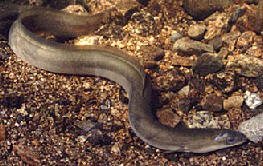|
The world's eels are disappearing fast and need protection before it's too late, fisheries scientists announced last week. Tomorrow the European Commission releases its 'Eel Action Plan' urging the European parliament to safeguard the region's threatened fish.
But eels' mysterious life-cycle and unappealing image - suspected as major reasons for their decline - may make protection tough.
"It's a global problem," says fisheries expert Håkan Wickström at Sweden's Institute of Freshwater Research in Drottningholm.
European eel (Anguilla anguilla) numbers have dropped 99% since 1978, Wickström told the annual meeting of the International Council for the Exploration of the Sea in Tallinn, Estonia. And American eels (A. rostrata) and Japanese eels (A. japonica) have experienced similar declines.
"If we don't manage eel populations now, there will be nothing left to manage," agrees Willem Dekker of the Netherlands Institute for Fisheries Research in Ijmuiden. In Europe alone such a crash could put 25,000 fishermen out of business.
All three species are probably suffering from the same pressures. European and American eels spawn in the same place - the currents of the Sargasso Sea in the Mid-Atlantic. Japanese eels spawn in a sea region with similar eddies southeast of Japan.
Pollution could be the culprit. Eels spawn just once, spend most of their lives in estuaries, and take 10 to 50 years to reach maturity. Over that time, persistent pollutants such as PCBs can build up to lethal concentrations in their sex organs, potentially poisoning their offspring. "They live where humans live: it's amazing they've survived so long," says Dekker.
Changes due to ocean warming, may also be playing a role; ditto over fishing. Demand for baby eels has risen - they are harvested for aquaculture to satisfy a growing Asian appetite. "Fishing is certainly beyond sustainable limits," says Dekker.
“They're not that sexy” - Håkan Wickström - Institute for Freshwater Research, Sweden
Tough regulations capping catches, like those for cod, are the only solution, experts argue. The eel fishing industry is as dispersed as the creatures themselves, with individuals or small businesses catching most.
Listing eels as endangered species probably won't work. Where eel fishing has been outlawed, says Dekker, poaching soon follows.
Eels' image problem may have compounded their fate. Fish biologists have neglected the eel to study celebrity fish such as salmon and tuna, laments Wickström. "They're not that sexy," he says.
See also
Variability in growth rate in European Eel Anguilla anguilla (L) in a Western Irish Catchment - W. Russell Poole and Julian D. Reynolds 1998 – pdf (167KB)
Centre of Environmental Management Research (CEMR).
European Eel (Anguilla anguilla) Behaviour & Migration Study
Top
|
